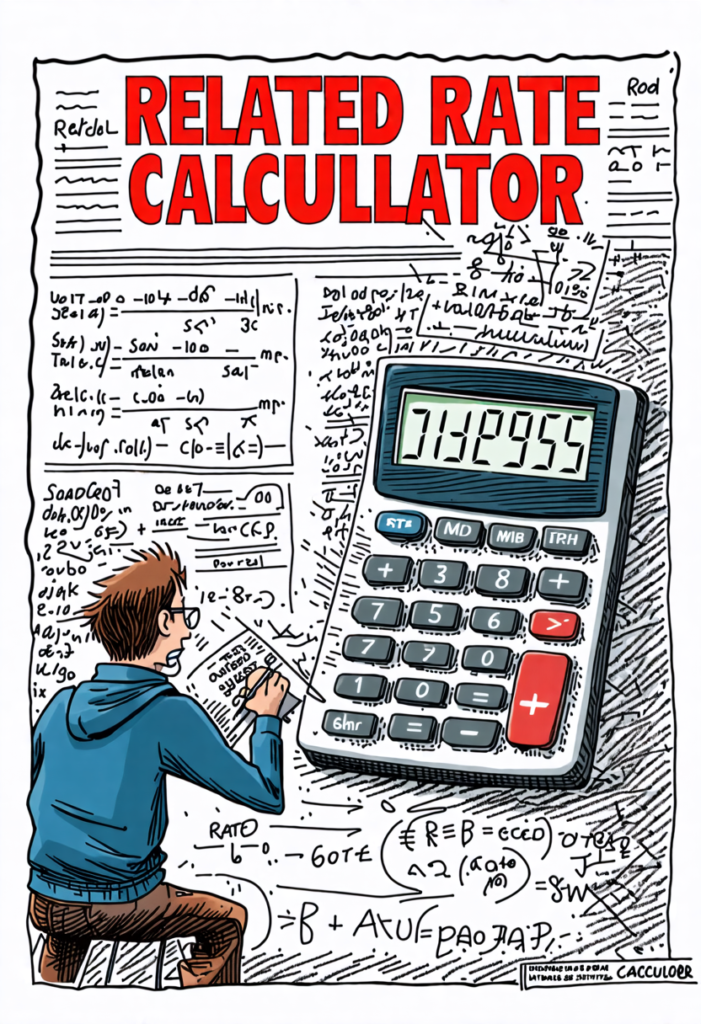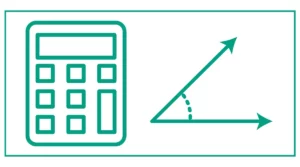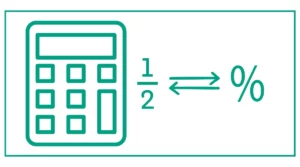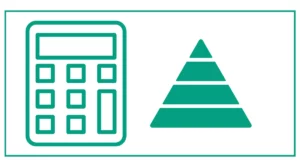Related Rate Calculator
The related rate calculator helps you calculate the rate at which two variables change at the same time.
Enter the change in the first value and the change in the second value relative to the value to calculate the related rate.
Related rates problems occur when there are two or more variables that change simultaneously, potentially at varying rates. By understanding the relationship between these variables and the rate of change of one of them, we can determine the rate of change of the other.
The formula of the related rates for x value is x˙=dx/dt , for y it is y˙=dy/dt
y˙=dy/dt=dy/dx⋅dx/dt=dy/dx.x˙

You might also want to determine the secant or pyramid triangle.
What Are Related Rates?
Related rates in calculus refer to the relationship between the rates of change of two or more interdependent quantities. These rates of change are typically expressed as derivatives with respect to time. When we have an equation that relates two or more variables, and these variables are changing over time, we can use related rates to determine how quickly one variable is changing in relation to another.
The key to solving related rates problems lies in understanding how to apply the chain rule of differentiation. This rule allows us to express the rate of change of one quantity in terms of the rate of change of another related quantity.
The Importance of Related Rates in Calculus
Related rates problems are an essential part of calculus courses, including Calculus AB. They help students develop critical thinking skills and apply calculus concepts to real-world situations. By mastering related rates, students can:
- Analyze complex systems with multiple changing variables
- Model and solve practical problems in physics, engineering, and economics
- Develop a deeper understanding of the relationships between different rates of change
- Enhance their problem-solving abilities in calculus and beyond
How to Approach Related Rates Problems
When tackling a related rates problem, it’s important to follow a structured approach. Here’s a step-by-step guide to help you solve these problems effectively:
- Read the problem carefully and identify the known and unknown rates of change.
- Draw a diagram if possible to visualize the situation.
- Identify the equation that relates the variables in the problem.
- Differentiate both sides of the equation with respect to time using the chain rule.
- Substitute the known values and rates into the differentiated equation.
- Solve for the unknown rate of change.
Let’s look at two examples to illustrate this process.
Example 1: The Ladder Problem
A 10 ft long ladder is leaning against a vertical wall. The bottom of the ladder is being pulled away from the wall at a rate of 2 ft/sec. How fast is the top of the ladder sliding down the wall when the bottom is 6 ft from the wall?
Step 1: Identify the known and unknown rates
- Known: The rate at which the bottom of the ladder is moving away from the wall (dx/dt = 2 ft/sec)
- Unknown: The rate at which the top of the ladder is sliding down the wall (dy/dt)
Step 2: Draw a diagram
(Imagine a right triangle with the ladder as the hypotenuse)
Step 3: Identify the equation
We can use the Pythagorean theorem: x² + y² = 100 (where 100 is the square of the ladder’s length)
Step 4: Differentiate both sides with respect to time
2x(dx/dt) + 2y(dy/dt) = 0
Step 5: Substitute known values
We know x = 6 ft and dx/dt = 2 ft/sec. We need to find y using the Pythagorean theorem:
y² = 100 – 6² = 64
y = 8 ft
Now we can substitute these values into our differentiated equation:
2(6)(2) + 2(8)(dy/dt) = 0
Step 6: Solve for the unknown rate
24 + 16(dy/dt) = 0
16(dy/dt) = -24
dy/dt = -1.5 ft/sec
Therefore, when the bottom of the ladder is 6 ft from the wall, the top of the ladder is sliding down at a rate of 1.5 ft/sec.
Example 2: The Expanding Sphere Problem
A spherical balloon is being inflated at a constant rate of 2 cubic feet per second. How fast is the radius of the balloon changing when the radius is 3 ft?
Step 1: Identify the known and unknown rates
- Known: The rate at which the volume is increasing (dV/dt = 2 ft³/sec)
- Unknown: The rate at which the radius is changing (dr/dt)
Step 2: Visualize the expanding sphere
Step 3: Identify the equation
We can use the formula for the volume of a sphere: V = (4/3)πr³
Step 4: Differentiate both sides with respect to time
dV/dt = 4πr²(dr/dt)
Step 5: Substitute known values
We know dV/dt = 2 ft³/sec and r = 3 ft. Let’s substitute these values:
2 = 4π(3²)(dr/dt)
Step 6: Solve for the unknown rate
2 = 36π(dr/dt)
dr/dt = 2 / (36π) ≈ 0.0177 ft/sec
Therefore, when the radius of the balloon is 3 ft, it is increasing at a rate of approximately 0.0177 ft/sec.
Using a Related Rate Calculator
While it’s crucial to understand the process of solving related rates problems manually, a related rate calculator can be a helpful tool for checking your work or quickly solving complex problems. Here’s how you can use the provided calculator:
- Enter the change in the first value (e.g., the rate of change of volume in the sphere problem).
- Enter the change in the second value relative to the first value (e.g., the rate of change of radius in relation to volume).
- The calculator will automatically compute the related rate.
Remember that while calculators are useful, they should not replace your understanding of the underlying concepts. Always strive to solve problems manually first to develop a strong grasp of related rates in calculus.
Applications of Related Rates in Real-World Scenarios
Related rates have numerous practical applications in various fields. Here are some examples:
- Physics: Calculating the rate of change of distance, velocity, or acceleration in motion problems.
- Engineering: Determining how quickly pressure changes in a system as volume or temperature changes.
- Economics: Analyzing how changes in supply and demand affect prices over time.
- Biology: Modeling the growth rate of populations or the spread of diseases.
- Manufacturing: Optimizing production rates and resource allocation in factories.
By mastering related rates, you’ll be equipped to tackle a wide range of real-world problems that involve changing quantities.
Common Challenges in Solving Related Rates Problems
While related rates are a powerful tool in calculus, students often face challenges when solving these problems. Here are some common difficulties and tips to overcome them:
- Identifying the correct equation: Practice setting up equations that relate the variables in the problem. This often requires visualizing the scenario or drawing a diagram.
- Applying the chain rule correctly: Review the chain rule and practice differentiating complex equations with respect to time.
- Keeping track of units: Always include units in your calculations and make sure they are consistent throughout the problem.
- Interpreting the results: Remember that rates of change can be positive or negative. Consider the physical meaning of your answer in the context of the problem.
- Dealing with implicit differentiation: Some related rates problems require implicit differentiation. Make sure you’re comfortable with this technique.

References
- Related Rates. (n.d.). Related Rates. web.ma.utexas.edu/users/m408n/AS/LM3-9-2.html
- 6.2 Related Rates. (n.d.). 6.2 Related Rates. whitman.edu/mathematics/calculus_online/section06.02.html





